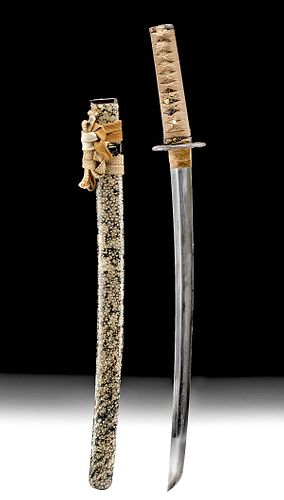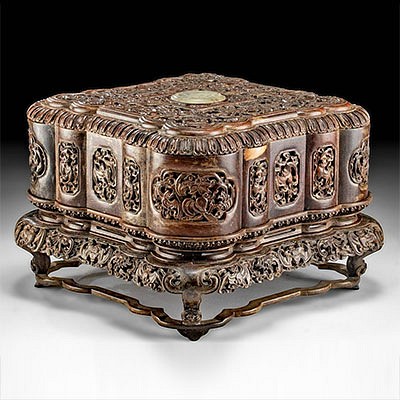Signed Japanese Edo Wakizashi + Scabbard
Lot 41
About Seller
Artemis Gallery
686 S Taylor Ave, Ste 106
Louisville, CO 80027
United States
Selling antiquities, ancient and ethnographic art online since 1993, Artemis Gallery specializes in Classical Antiquities (Egyptian, Greek, Roman, Near Eastern), Asian, Pre-Columbian, African / Tribal / Oceanographic art. Our extensive inventory includes pottery, stone, metal, wood, glass and textil...Read more
Categories
Estimate:
$2,500 - $3,500
Absentee vs Live bid
Two ways to bid:
- Leave a max absentee bid and the platform will bid on your behalf up to your maximum bid during the live auction.
- Bid live during the auction and your bids will be submitted real-time to the auctioneer.
Bid Increments
| Price | Bid Increment |
|---|---|
| $0 | $25 |
| $300 | $50 |
| $1,000 | $100 |
| $2,000 | $250 |
| $5,000 | $500 |
| $10,000 | $1,000 |
| $20,000 | $2,500 |
| $50,000 | $5,000 |
| $100,000 | $10,000 |
| $200,000 | $20,000 |
About Auction
By Artemis Gallery
Apr 8, 2021
Set Reminder
2021-04-08 10:00:00
2021-04-08 10:00:00
America/New_York
Bidsquare
Bidsquare : Fine Antiquities | Asian | Ethnographic Art
https://www.bidsquare.com/auctions/artemis-gallery/fine-antiquities-asian-ethnographic-art-6770
Features classical antiquities, ancient and ethnographic art from cultures encompassing the globe. Egyptian, Greek, Roman, Etruscan, Near Eastern, Asian, Pre-Columbian, Native American, African / Tribal, Oceanic, Spanish Colonial, Russian, Fine Art, so much more! All legally acquired, legal to sell. Artemis Gallery info@artemisgallery.com
Features classical antiquities, ancient and ethnographic art from cultures encompassing the globe. Egyptian, Greek, Roman, Etruscan, Near Eastern, Asian, Pre-Columbian, Native American, African / Tribal, Oceanic, Spanish Colonial, Russian, Fine Art, so much more! All legally acquired, legal to sell. Artemis Gallery info@artemisgallery.com
- Lot Description
East Asia, Japan, Edo period, ca. 1660s CE. A stunning wakizashi sword with a curved shinogi-zukuri blade that is signed "Tanba-no kami Yoshimichi." The scabbard (saya) is made of lacquered wood wrapped with stingray skin (samegawa) and the wooden handle (tsuka) is also wrapped with samegawa and cotton straps (tsuka-ito) and finally topped with a gilt brass cap (kashira). The tsuba hand guard is a round marugata shape with a dragon motif, and the tsuba sits just below a brass piece known as a fuchi. The handle fits snugly over the signed tang, with a pair of 45% (equivalent to 10K+) gold leaf shaped ornaments. The brass kashira cap tops the end of the hilt and is inlaid with gold foliate motifs as well. The blade has a nice forging, seemingly without flaws and still possessing a sharp cutting edge! Size in sheath: 27.5" L x 2.75" W (69.8 cm x 7 cm); size of blade: 18.25" L x 1.125" W (46.4 cm x 2.9 cm); quality of gold: 45% (equivalent to 10K+)
This traditional Japanese sword was both a weapon and a symbol of authority and social status. The wakizashi paired with the longer katana sword marked the wearer as a samurai. The shorter sword was seen as an auxiliary weapon, also used for fighting in close quarters. In addition, Wakizashi could be worn by non-samurai if worn alone, and members of the merchant class (chonin) wore them because of the frequency of encountering bandits when traveling between Japan's cities.
Provenance: ex-private Boulder collection, Colorado, USA; ex-private Southern California, USA collection
All items legal to buy/sell under U.S. Statute covering cultural patrimony Code 2600, CHAPTER 14, and are guaranteed to be as described or your money back.
A Certificate of Authenticity will accompany all winning bids.
We ship worldwide and handle all shipping in-house for your convenience.
#163345The scabbard has a chip and crack on the rim below the guard. Abrasion and two cracks on scabbard center near the tip. The blade is in excellent condition and very sharp. Discoloration to cotton wrapping, but intact and no fraying. Crack on one side of handle skin. Patina on signed tang, but signature is clear.Condition
- Shipping Info
-
All shipping is handled in-house for your convenience. Your invoice from Artemis Gallery will include shipping calculation instructions. If in doubt, please inquire BEFORE bidding for estimated shipping costs for individual items.
-
- Buyer's Premium



 EUR
EUR CAD
CAD AUD
AUD GBP
GBP MXN
MXN HKD
HKD CNY
CNY MYR
MYR SEK
SEK SGD
SGD CHF
CHF THB
THB














